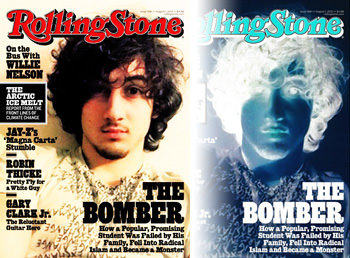Don’t Judge a Magazine by Its Cover
America's apparent outrage over the Rolling Stone cover featuring a photo of accused Boston bomber Dzhokhar Tsarnaev reveals a great deal about this country's insecurities and prejudices.
America’s apparent outrage over the Rolling Stone cover featuring a photo of accused Boston bomber Dzhokhar Tsarnaev reveals a great deal about this country’s insecurities and prejudices.
Twitter and Facebook are buckling under the strain of public ire. Major chains, including CVS drugstores, have said they will not sell the issue and others have joined in the boycott. All because Rolling Stone is publishing what USA Today calls a “glam cover.”
Is it a “glam” cover? Yes and no. Someone who never heard of Tsarnaev could easily mistake his image for that of a teen celebrity. Whatever Rolling Stone’s protestations, I find it hard to believe its editors didn’t realize they were putting an accused terrorist in Justin Bieber territory. But that’s kind of the whole point.
The image on the cover is paired with the headline, “The Bomber: How a Popular, Promising Student Was Failed By His Family, Fell Into Radical Islam and Became a Monster.” That doesn’t sound very glamorous. (Furthermore, as journalists we’re trained never to convict the accused, no matter how obvious his or her guilt, until a judge or jury has done so first. Tsarnaev just pleaded not guilty. By calling him “the bomber” and “a monster,” Rolling Stone is, perverse as it sounds, risking legal action.)
The article that is paired with the controversial cover quotes Tsarnaev’s wrestling coach: “I felt like a bullet went through my heart,” he says, after learning that the suspect is his former pupil. “To think that a kid we mentored and loved like a son could have been responsible for all this death. It was beyond shocking. It was like an alternative reality.”
By placing Tsarnaev’s good-looking mug in a spot normally reserved for pop stars and rockers, the magazine is merely illustrating the central question of the story. How did this kid, who, in an alternative reality, might have ended up on the cover of Rolling Stone for all the right reasons, end up there for all the wrong reasons? How did he become “a monster?”
That is apparently too complex a subject for Americans to cope with. Or, they seem to be tweeting, it’s OK to write about suspected terrorists, but you should run only unflattering photos of them.
Dzhokhar Tsarnaev does not look like hairy, brown, fat Khalid Sheikh Mohammed, the so-called architect of 9/11. Tsarnaev is nonetheless accused of heinous crimes. Seeing his handsome, boyish, American face stirs in our guts an uncomfortable dissonance. He does not look like “the other.” That, again, is the point of Rolling Stone’s article — not to glamorize a suspected terrorist, but to investigate his alleged descent into mass murder.
If this were a genuine “puff piece,” as they’re known, then I would share in the outrage. I find the opposite of such articles, simple-minded rants about evil, just as offensive. Neither style of writing does the essential work of journalism: to investigate and inform.
As Hannah Arendt so famously wrote, trying to understand the Holocaust, “The sad truth is that most evil is done by people who never make up their minds to be good or evil.” She understood that killers can be “terribly and terrifyingly normal.”
Rolling Stone isn’t just a delivery system for music industry PR. The magazine has a long and proud tradition, from Hunter S. Thompson to Matt Taibbi to Michael Hastings, of investigating important stories and provoking more profound thought, discussion and social change than can be attributed to the pages of USA Today. This article is no exception, and the issue’s cover is highly appropriate.
Your support matters…Independent journalism is under threat and overshadowed by heavily funded mainstream media.
You can help level the playing field. Become a member.
Your tax-deductible contribution keeps us digging beneath the headlines to give you thought-provoking, investigative reporting and analysis that unearths what's really happening- without compromise.
Give today to support our courageous, independent journalists.





You need to be a supporter to comment.
There are currently no responses to this article.
Be the first to respond.